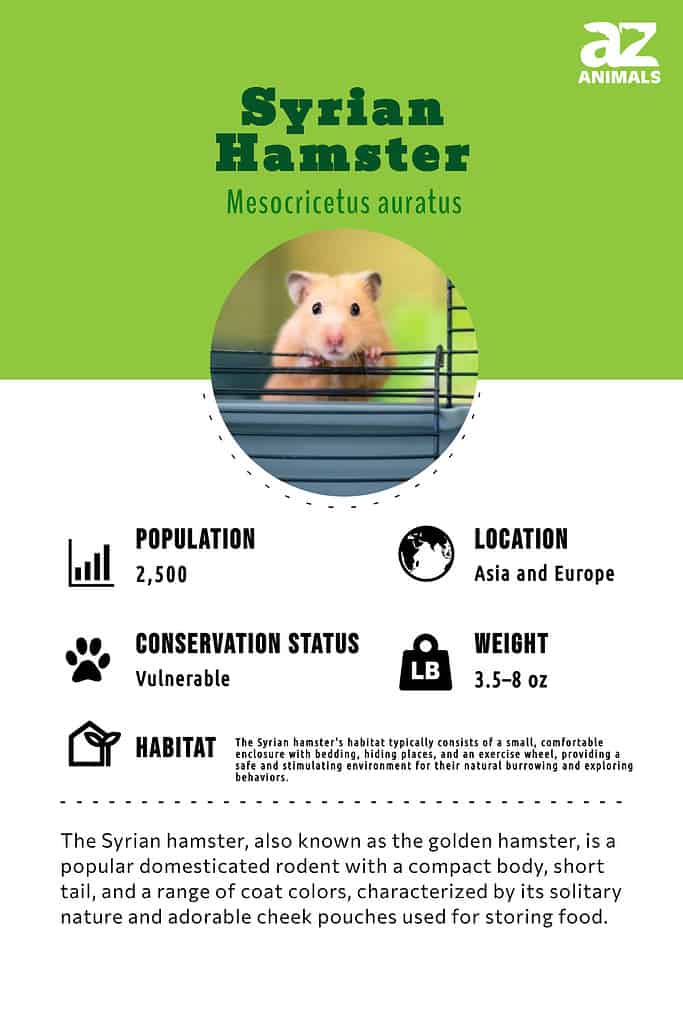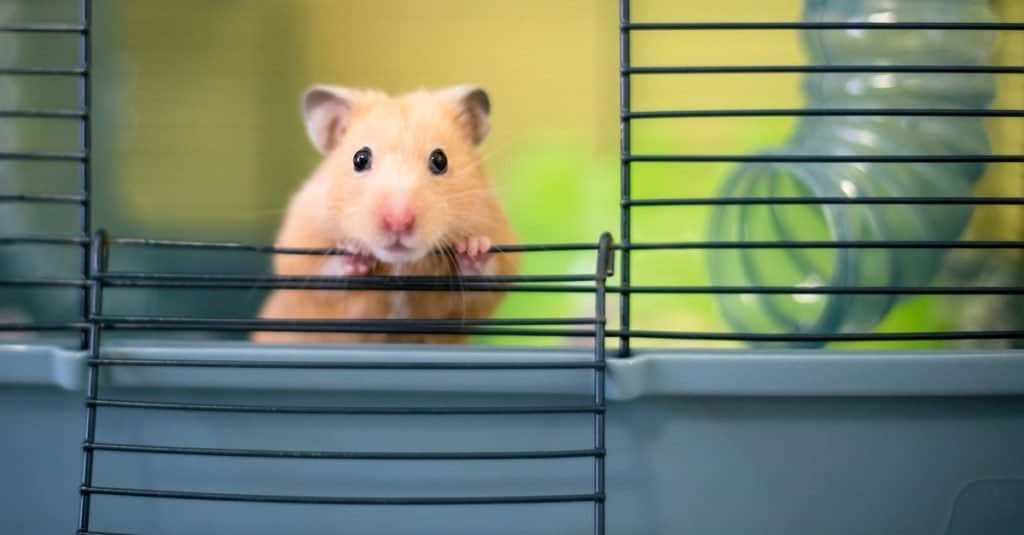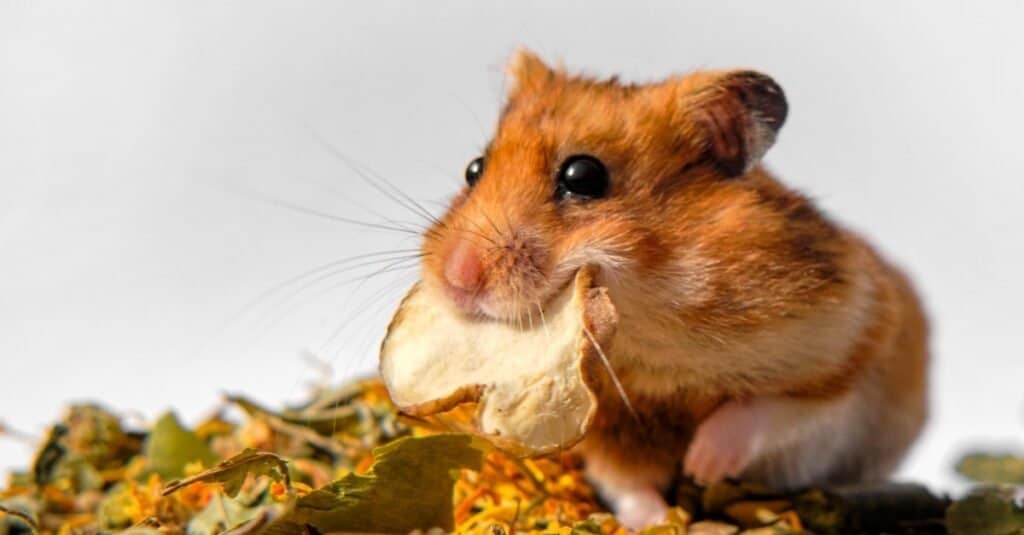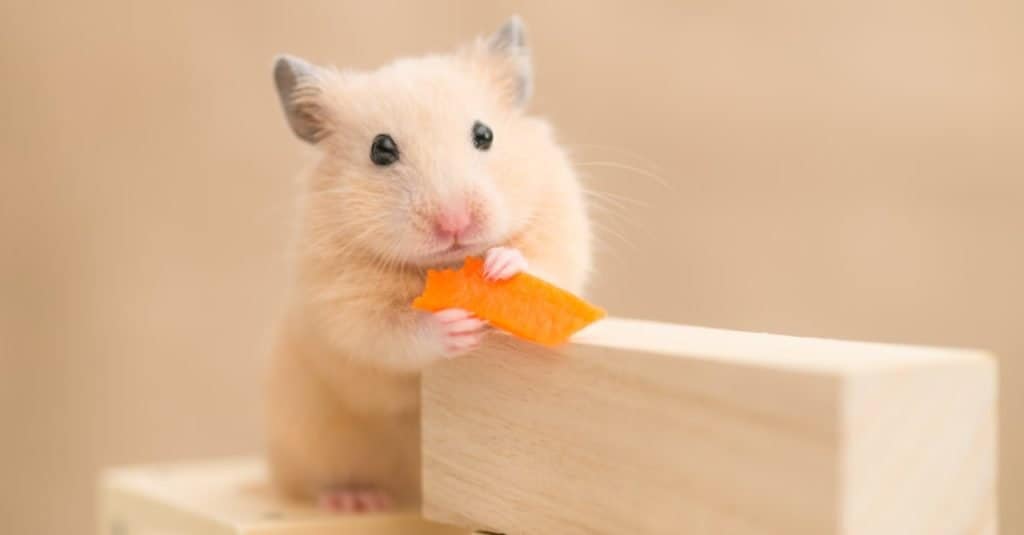Syrian Hamster
Mesocricetus auratus
Can get used to and respond to human voice
Advertisement
Syrian Hamster Scientific Classification
- Kingdom
- Animalia
- Phylum
- Chordata
- Class
- Mammalia
- Order
- Rodentia
- Family
- Cricetidae
- Genus
- Mesocricetus
- Scientific Name
- Mesocricetus auratus
Read our Complete Guide to Classification of Animals.
Syrian Hamster Conservation Status
Syrian Hamster Facts
- Prey
- Insects
- Name Of Young
- Pups
- Group Behavior
- Largely solitary
- Fun Fact
- Can get used to and respond to human voice
- Estimated Population Size
- Fewer than 2,500 mature individuals
- Biggest Threat
- Habitat loss
- Most Distinctive Feature
- Typical golden-brown color
- Other Name(s)
- Golden hamster, teddy bear hamster, standard hamster, fancy hamster
- Gestation Period
- 16 days
- Litter Size
- 8-20
- Habitat
- Plateaus, steppes, sand dunes, edges of deserts
- Predators
- Owls, weasels, storks, jackals, wild cats, snakes
- Diet
- Omnivore
- Type
- Rodent
- Common Name
- Golden hamster
- Number Of Species
- 4
- Location
- Syria and Turkey
Syrian Hamster Physical Characteristics
- Color
- Gold
- Skin Type
- Fur
- Lifespan
- 1-3 years
- Weight
- 100–225 grams (3.5–8 oz)
- Length
- 5-7 in (12.7-17.78cm)
- Age of Sexual Maturity
- 30 days
- Age of Weaning
- 19-21 days
View all of the Syrian Hamster images!

The Syrian hamster also called the golden hamster or teddy bear hamster is a popular pet and one of the most popular pet rodents around.
Its habitat is northern Syria and southern Turkey. Introduced to North America in 1936, it quickly became one of the first domesticated pet hamsters. With its small size, low price, ease of becoming tame, low maintenance, and fun to watch, it’s great for first-time hamsters or pet owners.
5 Incredible Syrian Hamster Facts!

Easy-to-access
guinea pig
cage doors make it much easier to remove your pet for cleaning
©Mary Swift/Shutterstock.com
- Communicates aggression through teeth chattering.
- Travels as much as 8 miles in one evening to find and catch food.
- It Compensates for poor vision by using its scent glands to leave a trail, which helps it find its way home.
- A group of hamsters is called a horde.
- Can store up to one ton of food in a lifetime.
Scientific Name

Orange Syrian Hamster eats food from topinambura feed.
©Kavaleuskaya Aksana/Shutterstock.com
The Syrian hamster, also called golden hamster, teddy bear hamster, standard hamster, or fancy hamster, belongs to the hamster subfamily Cricetinae, which contains 19 species divided into seven genera. Its scientific name is Mesocricetus auratus or Cricetus auratus. Mesocricetus is a genus of Old World hamsters that includes:
- Mesocricetus brandti: Turkish hamster or Brandt’s hamster
- Mesocricetus newtoni: Romanian hamster or Dobrudja hamster
- Mesocricetus raddei: Ciscaucasian hamster
Appearance

©Johannes Menge/Shutterstock.com
The colors of the Syrian hamster include the typical golden or golden-brown, plus self-colored, tortoiseshell, dominant spotted, and banded color patterns. Golden is the dark tan color resembling the wild coat, self-colored has continuous and unbroken coats in other colors, and dominant spotted has a white main body. Tortoiseshell is rare and has bands of red and black or grey and black, both with yellow spots on top, while banded has an even band of white around the midsection.
There are 26 different colors, markings, and breeds of hamsters. Syrian hamster coat colors can be:
- Beige
- Black
- Blonde
- Brown
- Chocolate
- Cream
- Dove
- Golden
- Grey
- Lilac
- Mink
- Sable
- Tan
- White
Syrian hamster hair textures can be short-haired, long-haired, rex, satin, or hairless. The short-haired hamsters bear the closest resemblance to their wild counterparts, with the offspring of one female hamster discovered in 1930 by Dr. Israel Aharoni and the first hamster discovered in the Aleppo region of Syria.
It is the long-haired hamsters that are called teddy bears or Angora hamsters, although only the long-haired males can get the very long coats that can grow up to 4 inches (10 centimeters) while the females’ coats remain fluffy. Rex-haired hamsters have curly, fluffy fur, satin hamsters have very glossy, shiny fur and hairless hamsters have a very thin fur coat resulting from a genetic mutation.
Adult Syrian hamsters are 5-7 inches (12.7-17.78cm) in length. They can weigh 100–150 grams (3.5–5.3 oz) or, from private breeders, 175–225 grams (6.2–7.9 oz). The Syrian hamster has expandable cheek pouches which extend from its cheeks to its shoulders, a feature shared with other members of its subfamily.
Evolution and Origins
The Syrian hamster’s original natural habitat is confined to a limited area in Northwest Syria, close to Aleppo, and its discovery and description were documented in the second edition of The Natural History of Aleppo, a book authored and edited by two Scottish physicians residing in Syria, which was published in 1797.
The Syrian or golden hamster, which is considered one of the most elusive hamster species, originally inhabited the Syrian deserts and faced near extinction due to hunting in the 1920s; nevertheless, in 1930, archaeologist Israel Aharoni discovered a nest of wild Syrian hamsters in Aleppo, Syria.
Furthermore, the process of domesticating the Syrian hamster commenced in the late 1700s as naturalists documented this species, also referred to as Mesocricetus auratus or the golden hamster, and later in 1930, medical researchers obtained breeding stock of Syrian hamsters for animal experimentation purposes, ultimately resulting in further domestication and the rise of this animal as a beloved pet.
Syrian Hamster Behavior

Syrian Hamster eating a carrot on building blocks.
©stock_shot/Shutterstock.com
Syrian hamsters, like other hamsters, communicate aggression through teeth chattering. They can get used to and respond to the human voice and are easy to tame. They hibernate in the wild during winter and only in captivity when the temperature drops below 8 degrees Celcius.
Syrian hamster behavior is solitary and territorial, with the exception being their socializing during the mating season. They mark their home ranges with their scent glands on their flanks, both for marking territory, identifying individuals, as well as helping them find their way home due to having poor vision. Male hamsters are unique in that they lick their bodies near the flank glands to dampen the fur and drag their sides along objects to mark their territory, while females use bodily secretions as well as feces.
Syrian hamsters were thought to be nocturnal, but they are actually crepuscular. They spend their daylight hours in burrows and become active at dusk, which is when they take multiple trips to forage between food sources and their burrow to find, carry and store food while avoiding the extremes of daytime and nighttime temperatures. They can travel as much as 8 miles in one evening to find and catch food but often travel 2-5 miles in a 24-hour period.
In a lifetime, one hamster can store up to one ton of food. They keep their food separated from their urination and nesting areas. The exception is very old hamsters with weak teeth, who soak hard seeds and nuts with urine in order to soften them for eating. Syrian hamsters are excellent housekeepers who clean their hoards of molding and rotting food. In the wild, they carry food home in their cheek pouches and empty them by pushing the food out through their open mouths from back to front with their paws until their pouches are empty. Sometimes, they may stuff their pouches so full that they cannot close their mouths.
A group of hamsters is called a horde. The Syrian hamster’s lifestyle is terrestrial, altricial, burrowing, browsing, fossorial, sedentary, cursorial, territorial, solitary, and (during mating season) polygynous.
Habitat

Curious male syrian hamster walking outdoors on the grass, looking straight at the camera.
©VeryOlive/Shutterstock.com
The natural habitat of the Syrian hamster is a small range in the Middle East which includes northern Syria and southern Turkey. Wild populations are found in fertile, agricultural, and densely populated areas on the Aleppian plateau in Syria. Their habitat includes arid or dry, warm areas with a preference towards steppes, sand dunes, and edges of deserts.
Diet
The Syrian hamster’s diet is omnivorous. Hence, it consumes a wide variety of food, including seeds, nuts, ants, flies, cockroaches, wasps, and other insects.
Predators and Threats
Typical predators of Syrian hamsters are owls, weasels, storks, jackals, wild cats, and snakes. The Syrian hamster population in Syria is threatened with habitat loss due to human development. Their burrow entrances start to appear and the animals are trapped and poisoned as pests. From May to June, fields are harvested, burned, and plowed and sheep clean out the remaining vegetation, which leaves Syrian hamsters without cover, nutrition, and winter food supply.
Reproduction and Life Cycle

The Syrian hamster is the most common pet hamster.
©iStock.com/Conny V
Male Syrian hamsters are polygynous, meaning that one male mates with several females. Breeding depends on long photoperiods, or when the day length is long. Females can birth young every month and go into heat (estrus) every four days even while already having a litter, which can often result in weak and undernourished pups. The gestation period is 16 days with a litter of 8-12, sometimes 20 but on average 8-10 altricial young born with closed eyes. The mother cares for them.
Some females may reduce large litters or respond to inexperience or feeling threatened with cannibalism, or in the wild during food shortages. They also eat their dead young and in captivity, wild females may kill and eat their young if the pups interact with humans and have their foreign scent. The young hamsters, or pups, open their eyes at 12-13 days and are weaned at 19-21 days. They reach sexual maturity in one month.
Adult female hamsters are called does and males are called bucks. Golden hamsters and other hamster species in the Mesocricetus genus all have the shortest gestation period of any known placental mammal at about 16 days. Although gestation can last up to 21 days, it usually results in complications.
The lifespan of the Syrian hamster is 2-3 years with a typical lifespan of 1-2.5 years and an average lifespan of 1.5-2 years. Syrian hamsters behave similarly in cages as they do in the wild.
Population
According to the IUCN Red List, the exact number of the Syrian hamsters population is unknown, but it is estimated that the total population is fewer than 2,500 mature individuals in the wild. This species is listed as Vulnerable (VU) with its numbers decreasing due to habitat loss.
View all 293 animals that start with SSyrian Hamster FAQs (Frequently Asked Questions)
Is a Syrian hamster a good pet?
Yes, Syrian hamsters are very good pets, especially for people who have never owned a hamster or any other pet before.
Do Syrian hamsters bite?
Yes, they bite, but not because of hatred or aggression towards humans but because they are prey animals. They bite due to fear and being untamed, annoyed, or mistaking your finger for food.
Are Syrian hamsters cuddly?
Yes, Syrian hamsters can be cuddly and are most affectionate towards owners who have gotten their trust.
Do Syrian hamsters get lonely?
No, Syrian hamsters are not known for being lonely with regard to other hamsters but appreciate regular human interaction. They are best kept in their own separate cages. Keeping two Syrian hamsters together in one cage can really only be successfully done while they are young, and when they become mature they become territorial and can even fight to the death. If you are planning to have multiple Syrian hamsters, you should go ahead and get cages for each of them.
How much do Syrian hamsters cost?
The price of a Syrian hamster is $25. This does not include the price for a cage, bedding, toys, food, and water holders.
Where can you buy a Syrian hamster?
You can buy Syrian hamsters from private breeders or local pet stores.
How do you tame a Syrian hamster?
You can tame a Syrian hamster with regular interaction by first getting him used to your hand and then feeding treats from it. Let him sniff your hand and put the treats in his food bowl for later. Do this for several days and then you can try picking him up.
How long do Syrian hamsters live?
The lifespan of a Syrian hamster is 1-3 years.
Are Syrian hamsters carnivores, herbivores or omnivores?
Omnivores.
What are the differences between a Dwarf hamster and a Syrian hamster?
The major difference between a Dwarf hamster and a Syrian hamster is size, and the Syrian is significantly larger. Other key differences include their appearance and behavior.
Apart from the fact that they are both hamsters, spotting the differences between the two breeds is relatively easy. Both can have long or short-haired coats, which come in various colorations and markings.
Thank you for reading! Have some feedback for us? Contact the AZ Animals editorial team.
Sources
- Wikipedia / Accessed May 24, 2021
- Animalia / Accessed May 24, 2021
- Dwarf Hamster Guide / Accessed May 24, 2021
- Pet Rodents Care / Accessed May 24, 2021
- Critter Chaws / Accessed May 24, 2021
- Pet Pad / Accessed May 24, 2021
- Hamstergeek / Accessed May 24, 2021
- First Hamster / Accessed May 24, 2021
- Animals HQ / Accessed May 24, 2021


















